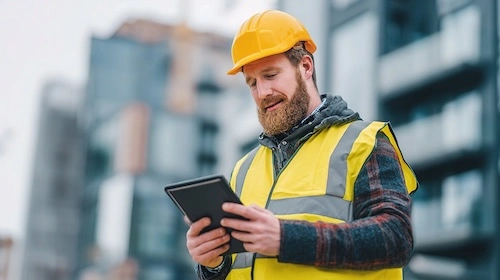The figure of the Construction resident is key to any construction project. It is not just the person who “is on site”: it is the one who resolves, coordinates, reports and ensures that physical progress is aligned with the program, plans and technical agreements.
Today, more than ever, the resident's work can (and should) be done Without paper, with digital tools and a smart kit, focused on mobility, traceability and efficiency.
Here's what you can't miss in the basic kit for a modern resident, adapted to the digitization standards that are already being adopted in the most important works in the country.
1. Personal protective equipment (PPE)
Safety will always be a priority. The resident must have:
• Helmet
• Reflective vest
• Boots with cap
• Safety glasses
• Heavy duty gloves
• Hearing protection (if applicable)
• Appropriate clothing depending on the weather and exposure
All PPE must be in good condition and used at all times. Technology can help you verify correct use, through photos or automated registrations.
2. Mobile device with access to a construction platform
The center of operational work is no longer a notebook or a folder: it is a connected mobile device.
Your team should include:
• Rugged smartphone or tablet
• Reliable mobile network access (4G or higher)
• Buildpeer installed as the main management platform
• Physical support (cover, harness or clip) to keep it always accessible
• Portable charger or backup battery
From this device, the resident will be able to review plans, tasks, reports, photographs, minutes, RFIs, pending projects and the work program, all in real time and without paper.
3. Drone for aerial visual documentation
In large scale works or with multiple fronts, the use of Drones becomes a powerful tool for the resident. It's no longer just about taking photos from your cell phone, but about document the progress with aerial vision, in a clear and professional manner.
The drone allows:
• Get panoramic images of the overall trailer
• Record the locations of key elements or interferences
• Generate visual sequences for weekly or monthly monitoring
• Link the shots directly to the work program within Buildpeer
• Have clear evidence for reports, progress meetings or external inspections
The resident does not need to operate the drone directly, but must be able to request flights according to technical needs, interpret the results and upload them to the corresponding digital platform.
Advice: establish a minimum frequency of flights (weekly or per milestone) and define a person responsible for uploading images to Buildpeer.
4. Access to tasks, managers and key dates
A resident needs to know:
• What should be executed today
• Who is responsible for each activity
• If there are deviations in the program
• What agreements have been made previously
All of this should be available from your device, through tools such as lists of assigned tasks, views of the work program and internal communication within Buildpeer.
There is no longer a reason to print the program or paste it on the site: today it is being consulted, updated and validated In digital.
5. No paper: all documentation, digital
The resident must not carry folders, sheets or notebooks. Everything should be:
• In the cloud or within the platform
• Available for consultation, update or evidence
• Linked to plans, tasks or managers as the case may be
This includes:
• Daily reports
• Attendance control
• Changes and revisions of plans
• Quality checklist
• Incidents or findings
• Requests for Information (RFIs)
Each one can be generated or answered from Buildpeer, eliminating the use of paper and ensuring full traceability.
6. Digital habits and professional approach
The kit isn't just physical. It also involves a professional and digital mentality. A modern resident must:
• Record everything with visual evidence and traceability
• Follow tasks based on the program, not on memory
• Avoid informal chats and use centralized communication
• Review and close pending issues from a platform, not on a makeshift field
• Provide timely monitoring of each contractor from their device
7. Auxiliary tools
Although the goal is to reduce physical equipment, there are some items that are still useful:
• Measuring tape
• Marker spray
• Multipurpose knife
• Work markers
• Water and personal hydration
• Hat, sunscreen or raincoat (depending on the weather)
Everything else must migrate to the digital world.
Why standardize this kit?
Because having a clear, digitized kit:
• Reduce rework due to poor communication
• Save time on supervisory visits
• Improves the quality of reports
• Provides useful evidence in real time
• Professionalizes the resident's role
And above all, it allows information flow from field to office without friction, which is key in complex works or with many actors.
Buildpeer, the center of the modern kit
If your team already has Buildpeer, you've already taken the most important step.
All that remains is to standardize its use as part of the resident's daily kit. Every photo, comment, task or agreement that is registered on the platform It's time saved, errors avoided and control assured.
Because today, a resident with paper is limited.
But a resident with Buildpeer, Are you ready to build to the next level.

